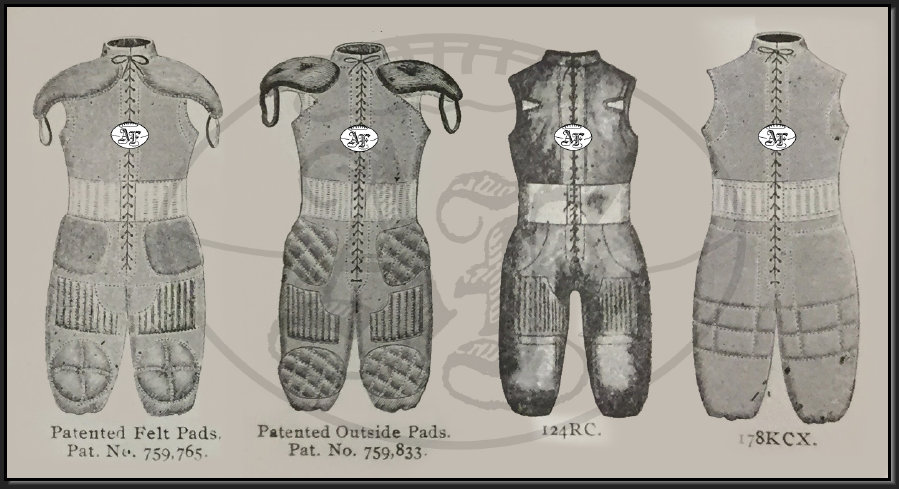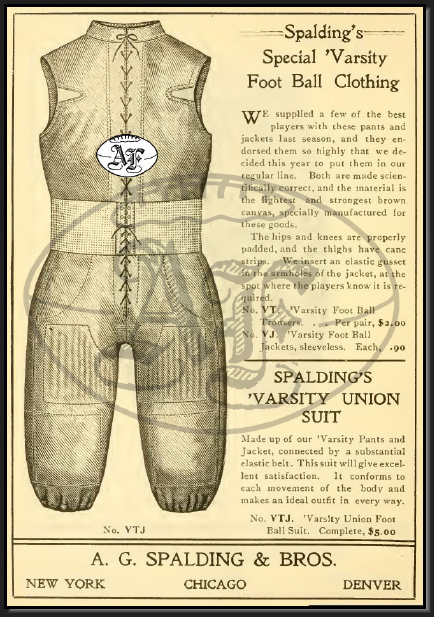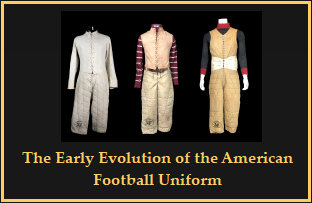






Questions or comments? Please email me at:

June 2021
c. 1907-1910 Football Union Suit


Stall & Dean Union Suits, 1905

Spalding Varsity Union Suit Ad,
Spalding Official Football Guide for 1902.
Spalding Official Football Guide for 1902.
Goldsmith Union Suit Ad,
P. Goldsmith Fall & Winter Catalog, 1907
P. Goldsmith Fall & Winter Catalog, 1907
I've been searching for a one-piece football union suit since 2010 as part of a quest to assemble a collection of pre-1920's uniform exemplars from each decade of the early game. I've asked dealers to notify me if they see one, reached out to fellow collectors in hopes of working a trade, and watched sports auctions and Ebay religiously, all to no avail. One example did appear at the 2017 National, but someone had written "1898" across the chest, which was earlier than the uniform's 1901 initial manufacture date. I was convinced a better example was just around the corner and passed on it...and have kicked myself every year thereafter.
Representing the predominate style of football uniform between 1901 and 1915, a surviving union suit examples surely would come up for auction over a ten year period, right? Wrong. Why not? Are they just exceedingly rare? Have a handful of collectors and museums hoarded the known examples? Or, was I in the midst of one of those anomalous collecting dead periods for that particular piece? I learned a valuable lesson with one of those early on in my collecting hobby. After searching for a few years I overspent on a Princeton head harness I had desperately wanted for my collection, only to have 3 other examples come up for sale in the next few months....each selling for less than half of what I paid.
In the end, my football union suit came from a militaria collector and museum professional who had acquired the suit over ten years ago at a flea market in Ohio. He happened to be passing a vendor who was putting out his wares at the beginning of the show and bought the suit believing it might be a military flight or jump suit. When he returned home he realized it was football and put it away in a closet. Ten years later he was contemplating selling some of his collection and in searching the internet for more information on his uniform found AntiqueFootball and offered it me for sale.
Based on my experience over the past 15 years, I'd give the football union suit a rarity index score of 8 out of 10 (yes, I just made that up). Then again, it's highly likely that, now that I own one, a floodgate will open and numerous examples will soon appear on EBay.
Representing the predominate style of football uniform between 1901 and 1915, a surviving union suit examples surely would come up for auction over a ten year period, right? Wrong. Why not? Are they just exceedingly rare? Have a handful of collectors and museums hoarded the known examples? Or, was I in the midst of one of those anomalous collecting dead periods for that particular piece? I learned a valuable lesson with one of those early on in my collecting hobby. After searching for a few years I overspent on a Princeton head harness I had desperately wanted for my collection, only to have 3 other examples come up for sale in the next few months....each selling for less than half of what I paid.
In the end, my football union suit came from a militaria collector and museum professional who had acquired the suit over ten years ago at a flea market in Ohio. He happened to be passing a vendor who was putting out his wares at the beginning of the show and bought the suit believing it might be a military flight or jump suit. When he returned home he realized it was football and put it away in a closet. Ten years later he was contemplating selling some of his collection and in searching the internet for more information on his uniform found AntiqueFootball and offered it me for sale.
Based on my experience over the past 15 years, I'd give the football union suit a rarity index score of 8 out of 10 (yes, I just made that up). Then again, it's highly likely that, now that I own one, a floodgate will open and numerous examples will soon appear on EBay.
Rarity
My June 2021 Artifact of the Month is a circa 1907-1910 football union suit. Other than some minor staining and a few small holes, the union suit is in like-new condition. I've paired it with a contemporaneous circa 1908 Peter's Arms and Sporting Goods turtleneck football jersey. The suit is the largest pre-1910 football uniform I've ever seen, as it is too big for the 6' - 2" mannequin display. There's no manufacturer's tag present, but the style is similar to the P. Goldsmith No. 184, manufactured in Cincinnati, Ohio where the suit is believed to come from. There is no other identifying information other than the name "Hoskins" written on the interior.
A.G. Spalding & Bros. Union Suit Ad, 1911

Football Teammates wearing one-piece union suits, circa 1910
Football player in union suit, circa 1905.
The predominate 19th century football uniform consisted of a smock jacket, jersey, and quilted pants. This combination rendered players difficult to tackle, but required a player to wear a belt and left a vulnerable seam between the pants and jacket. In 1901, A.G. Spalding & Bros. offered a solution by combining their Varsity Foot Ball Trousers with their Varsity Football Sleeveless Jacket with a connecting elastic belt, creating a one-piece, lace up football uniform they called "Spalding's Varsity Union Suit." The name came from long underwear that was first patented in 1868. Spalding's 1901-1905 design, which retailed for $5.00 in 1902, was manufactured out of brown canvas and featured a high collar and cane strips at the thighs. By 1906, additional crew-neck and v-neck style football jackets and union suits were offered by multiple manufacturers, and with a variety of sewn-on shoulder, hip, and knee pad configurations.
A typical union suit weighted approximately 5 pounds dry and significantly more when wet. As the speed of the game and the need for supplemental padding increased in the mid-1910's, the union suit fell out of favor with footballers. New leather shoulder and collarbone pads provided greater protection but were difficult to wear beneath a union suit. Jerseys and pants with built-in hip and thigh pads would become standard equipment by 1920.
A typical union suit weighted approximately 5 pounds dry and significantly more when wet. As the speed of the game and the need for supplemental padding increased in the mid-1910's, the union suit fell out of favor with footballers. New leather shoulder and collarbone pads provided greater protection but were difficult to wear beneath a union suit. Jerseys and pants with built-in hip and thigh pads would become standard equipment by 1920.